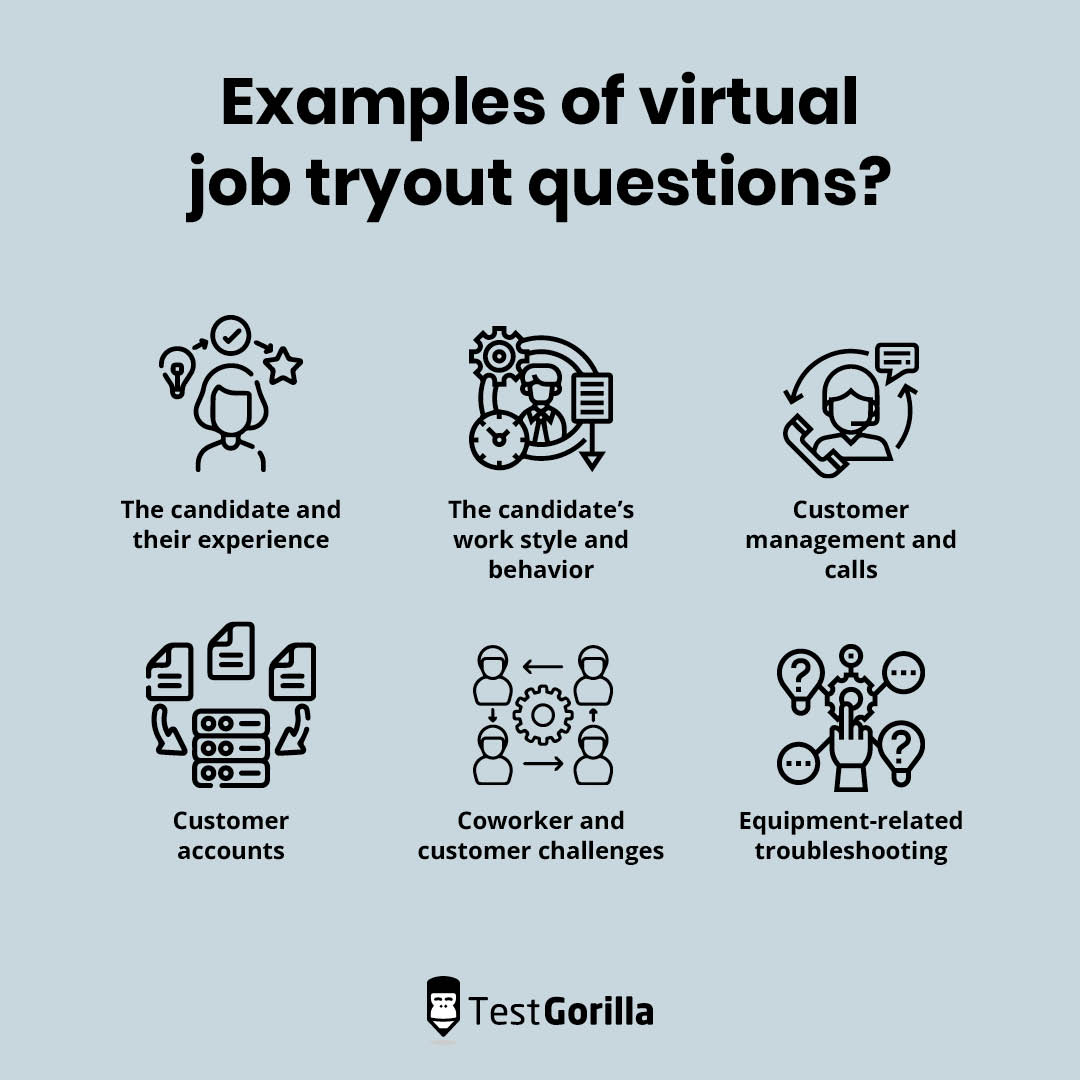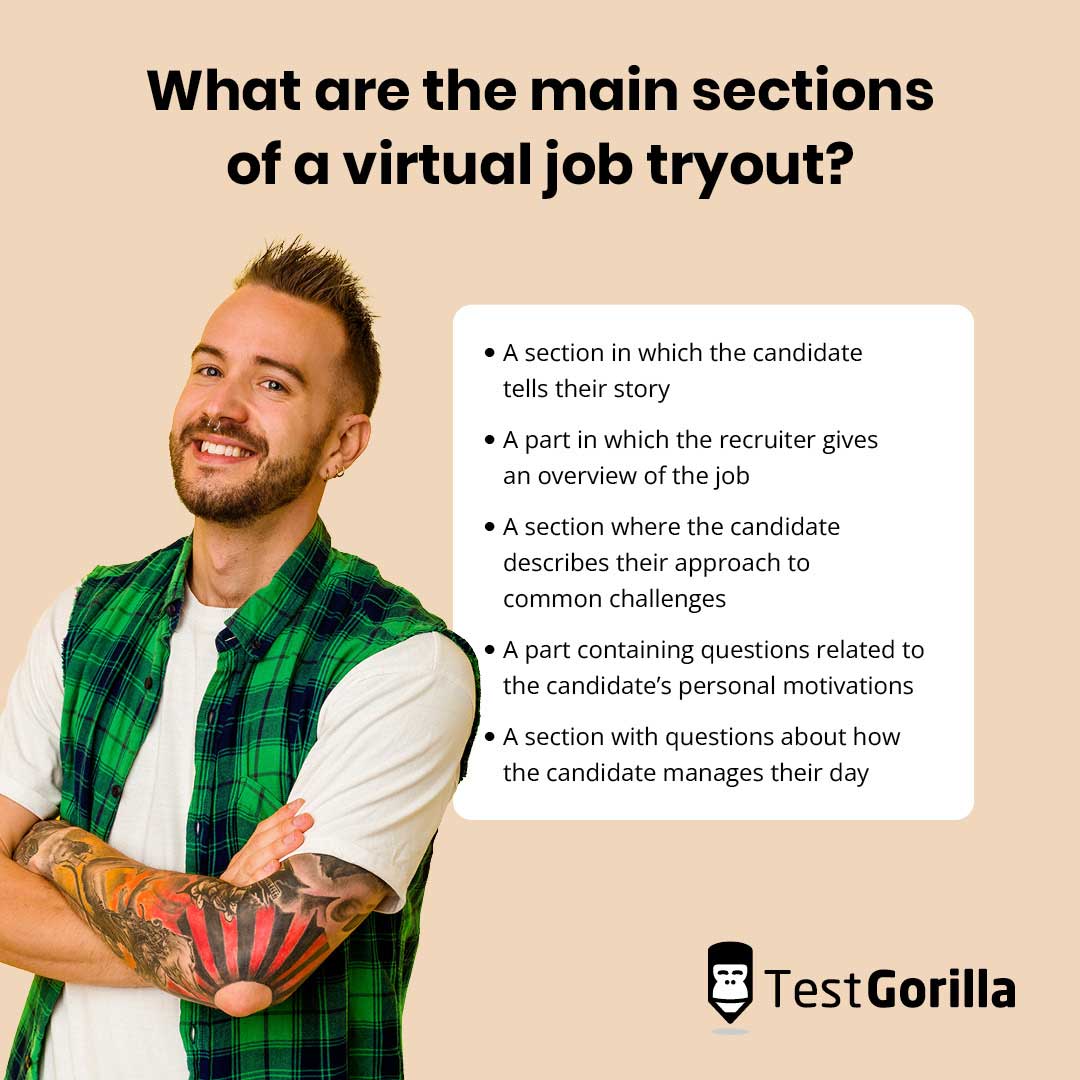A guide to optimizing the hiring process with virtual job tryouts
Costly hiring mistakes are not only financially damaging to your business but also harm employee morale and productivity. So, what’s the best way to avoid hiring mistakes and hire the perfect candidate? Virtual job tryouts are one effective method.
A virtual job tryout offers you a way to simulate your work environment for your candidates and complete a trial run before officially hiring someone.
If you want to implement virtual job tryouts when hiring customer service professionals or call center representatives but are unsure how to include them in your hiring process, read this guide for the key details.
Table of contents
- What is a virtual job tryout?
- What are some examples of virtual job tryout questions?
- What are the main features of a virtual job tryout assessment?
- What are the main sections of a virtual job tryout?
- What are the advantages of a virtual job tryout?
- What to avoid when arranging a virtual job tryout
- Hire the best talent using virtual job tryouts and TestGorilla
What is a virtual job tryout?
A virtual job tryout, or VJT, is a simulation of a job that employers use during the hiring process to help determine whether a candidate is suitable for a role.
Finding a suitable candidate and avoiding mis-hiring is critical. Statistics show that a single bad hire costs organizations an average of $14,900, though this figure can be as high as $240,000.
You can review your candidates’ abilities and ensure they understand the expectations of the job with a virtual job tryout, which offers a mutually beneficial experience for you and your candidates.
Most virtual job tryouts use a predictive modeling method and consist of tests related to the role. For example, if you’re hiring a customer service representative, you could integrate a Customer Service test in the tryout. The results of the test accurately predict your candidates’ performance in the role.
What are some examples of virtual job tryout questions?
When hiring a customer service representative or a call center professional, you may ask several questions in the virtual job tryout to analyze your candidates’ experience and knowledge. These virtual job tryout questions can involve the following:
The candidate and their experience
The candidate’s work style and behavior
Customer management and calls
Customer accounts
Coworker and customer challenges
Equipment-related troubleshooting
Some examples of specific virtual job tryout questions include situational judgment questions like those in the following list:
Eric is a skilled team leader with years of experience in the company; however, his coworkers noticed him taking office supplies home without returning them. Even after Eric was warned against this, his coworkers saw him take a tablet home without returning it. How would you handle the situation?
Fatima’s customer support experience is exceptional; however, in one recent encounter with a customer, her coworkers noticed that she was slightly dismissive of their complaints. Fatima claimed she was stressed. What action would you take if you were Fatima?
Eliot is normally skilled at handling customers’ account-related questions; however, the team noticed that he was unable to solve a complex issue related to customer account authentication and signing in. What would you do if you were Eliot?
How would you describe the key factors that motivate you to remain productive at work? Choose the answer that best describes your top motivational factor in a customer service environment:
I enjoy solving problems for customers
I have a supportive team
I can empathize with customers who experience difficulties with our services
The best insights on HR and recruitment, delivered to your inbox.
Biweekly updates. No spam. Unsubscribe any time.
What are the main features of a virtual job tryout assessment?
Many virtual job tryout assessments feature different types of tests, including personality tests such as the Big 5 (OCEAN) test and situational judgment tests like the Time Management test or Communication test.
We also recommend including role-specific tests in your virtual job tryout. For instance, if you’re hiring a manager or data analyst, you can include tests such as an Exploratory Data Analyst test or a Working with Data test.
The candidates’ test results will give you insights into their skills and personalities, which you can use to hire the most suitable candidates
What are the main sections of a virtual job tryout?
Each virtual job tryout is unique, but the following examples show some of the main sections you can include in your tryout:
A section in which the candidate tells their story
A part in which the recruiter gives an overview of the job
A section where the candidate describes their approach to common challenges
A part containing questions related to the candidate’s personal motivations
A section with questions about how the candidate manages their day
What are the advantages of a virtual job tryout?
In addition to avoiding costly hiring mistakes and getting a preview of your candidates’ work styles, a virtual job tryout can reduce your turnover and ensure your employees are engaged in the role.
Using a virtual job tryout can also enhance the candidate experience. Since your applicants can participate in the trial remotely, there’s no need for them to commute to your office.
In addition, including the best tests in a virtual job tryout can help you reduce unconscious bias since you can use the test results to check candidates’ suitability before you hire them. This eliminates one barrier preventing you from hiring cognitively diverse teams.
What to avoid when arranging a virtual job tryout
Businesses are expected to conduct more virtual job tryouts because of the rise in remote work since the pandemic and companies’ increasing need to find candidates who can successfully work remotely.
If you’re interested in including virtual job tryouts in your hiring process, consider the following ways to avoid issues that can affect the candidate experience:
Don’t eliminate candidates just because their technology fails momentarily. Your candidate may have the skills required for the job, and excluding them because of a temporary glitch may hinder your ability to find a suitable candidate.
Avoid conducting a virtual job tryout that lacks human interaction. Aim to meet with your candidates using video conferencing software to enhance the candidate experience.
Don’t make a hire without considering nonverbal cues and your candidates’ responses to questions. When you meet your candidates virtually, consider their tone and body language as they answer your questions.
Hire the best talent using virtual job tryouts and TestGorilla
A virtual job tryout can help you avoid the costs of hiring mistakes. If you want to include suitable tests in your virtual job tryout, the best platform to find them is TestGorilla.
We offer plenty of tests you can integrate into your virtual job tryout, from personality tests to role-specific tests. No matter which skills you need to assess, you’ll find tests for them with TestGorilla.
To try TestGorilla for free and find suitable tests for your tryout, head to our website and check out our test library. Incorporate a virtual job tryout into your hiring process with TestGorilla to hire the right talent.
You've scrolled this far
Why not try TestGorilla for free, and see what happens when you put skills first.





















